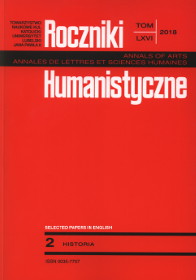The Image of Parish Clergy Based on Wincenty de Seve’s Inspection (1608–1609)—Selected Aspects
The Image of Parish Clergy Based on Wincenty de Seve’s Inspection (1608–1609)—Selected Aspects
Author(s): Anna JabłońskaSubject(s): History, Modern Age, 17th Century
Published by: Towarzystwo Naukowe KUL & Katolicki Uniwersytet Lubelski Jana Pawła II
Keywords: Council of Trent; Church reform; parish clergy; inspection; Wielkopolska; Archdiocese of Gniezno
Summary/Abstract: The Polish version of the article was published in Roczniki Humanistyczne vol. 65, issue 2 (2017). The article discusses an important period in Church history, namely the so-called Church reform. It occurred after King Zygmunt August (1564) and the Polish clergy (1577) had adopted the resolutions of the Council of Trent. The implementation of those resolutions started at the turn of the 17th century. One of the proposals was to renew the life of clergy—their attitude to obligations and improvement of morals, customs and even appearance. Wincenty de Seve’s inspection in the years 1608–1609 concerned the area of the archdeaconry of Gniezno. For the purposes of this article, its four deaneries were analysed, i.e. Holy Trinity, Saints Peter and Paul, Łekno and Sompolno.The main purpose of the visitation was to inspect the parish, which played an extremely important role in society. The article discusses the image of the parish clergy emerging from the findings of the inspection, which took into account guidelines for the reform. This image shows that both those who were role models and those who drastically violated various norms were exceptions. The most numerous group were priests, who mostly met the requirements, but various irregularities were noticeable. The biggest problems of the next, slightly smaller group were women and alcohol. The offences also included ignorance, sloppiness and inappropriate clothing.The inspection shows that at the beginning of the 17th century, attempts were made to implement the reform of parish clergy, but traces of old habits and new requirements were still to go hand in hand.
Journal: Roczniki Humanistyczne
- Issue Year: 66/2018
- Issue No: 2SP
- Page Range: 179-198
- Page Count: 20
- Language: English

